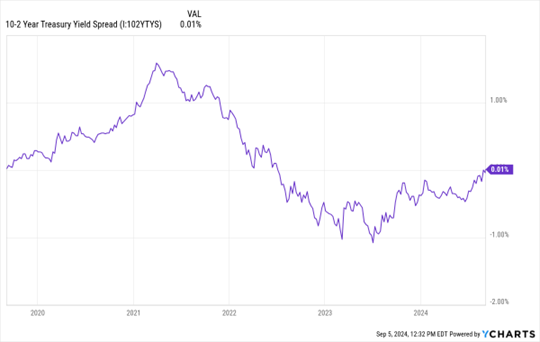The yield curve is about to turn positive, and that could mean a widely followed recession indicator gave a false signal for most of the last two years. The yield curve is a plot of the yields on Treasury debt of different durations. A normal yield curve is positively sloped, explains Bob Carlson, editor of Retirement Watch.
Typically, the debts with the lowest durations (such as Treasury bills) have the lowest interest rates. The rates are higher on longer-duration Treasury debt, with 30-year bonds having the highest interest rates.
A negatively sloped yield curve is the opposite. The shortest-term debt has higher yields than longer-term debt. A negative yield curve usually is caused by the Federal Reserve raising short-term interest rates to slow economic growth and reduce inflation.
2-Year/10-Year Spread
Data by YCharts
This chart shows the difference between the yield on the 2-year Treasury Note and the 10-year Treasury Note. The yield curve, as measured by this spread, has been negative for more than 540 trading days, according to Bespoke Investment Group. That’s the longest period on record that the curve has been negative. Previously, recessions followed when the yield curve was negative for 100 days or more.
But unless the economy drops into a recession soon, it appears the recession indicator didn’t work this time. With the Fed ready to cut interest rates at its September meeting, market interest rates on short-term Treasury debt have been declining. The yield curve isn’t positive yet, but it is close and probably will turn positive in the coming days or weeks.
Economic growth in recent years wasn’t driven by a lot of private sector borrowing stimulated by low interest rates. Instead, the federal stimulus programs and federal borrowing drove the growth.
So, when the Fed raised interest rates beginning in 2022, the private sector wasn’t affected much. Households and businesses could continue to spend, and the economy could keep growing.
Also, the gradual reduction in the federal stimulus caused spending to slowly decline. That, plus improvements in the supply of goods, brought inflation toward the Fed’s target without a recession.
The Fed is now worried enough about a recession that it will reduce interest rates before there’s a substantial decline in the labor market. Because the Fed wants to avoid a recession more than it wants to bring inflation to its target rate, it will cut rates and help bring about a positive yield curve without waiting for growth to tumble.










